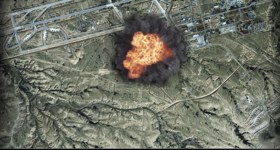21st Century Wire says…
As the Japanese government, in collusion with TEPCO (and almost every corporate mainstream media worldwide), continue to downplay the apocalyptic meltdown at the Daiichi nuclear power facility in Fukushima, Japan – the invisible menace continues to pump life-threatening radiation into the earth’s atmosphere.
The reason for the silence is twofold. The corporate nuclear mafia wish to avoid spending any money which could severely affect their future bottom-line profits. In addition to this, they are also very keen to avoid any heavy legal action based on their guilt due to not safeguarding the toxic radioactive fuels and waste stored on site.
Due to corporate psychopathy – they have put their precious profits over human lives, and have placed billions of innocent lives of this generation – and the next, at fatal risk. To call this debacle criminal would be a gross understatement.
It’s genocidal…
Fresh plumes of most probably radioactive steam have been detected rising from the reactor 3 building at the crippled Fukushima nuclear plant, said the facility’s operator company.
The steam has been detected by surveillance cameras and appeared to be coming from the fifth floor of the mostly-destroyed building housing crippled reactor 3, according to Tokyo Electric Power Co (TEPCO), the plant’s operator.
 The steam was first spotted on December 19 for a short period of time, then again on December 24, 25, 27, according to a report TEPCO published on its website.
The steam was first spotted on December 19 for a short period of time, then again on December 24, 25, 27, according to a report TEPCO published on its website.
The company, responsible for the cleanup of the worst nuclear disaster since Chernobyl, has not explained the source of the steam or the reason it is rising from the reactor building. High levels of radiation have complicated entry into the building and further inspection of the situation.
Three of the plant’s reactors suffered a nuclear meltdown in March 2011 after the Great East Japan Earthquake and resulting tsunami hit the region. The plant is comprised of six separate water boiling reactors. At the time of the earthquake, reactor number 4 had been de-fueled and reactors 5 and 6 were in cold shutdown for planned maintenance, thereby managing to avoid meltdowns.
Unlike the other five reactors, reactor 3 ran on mixed core containing both uranium fuel and mixed uranium and plutonium oxide, or MOX nuclear fuel. The Reactor 3 fuel storage pond still houses an estimated 89 tons of the plutonium-based MOX nuclear fuel composed of 514 fuel rods.
In a similar incident, small amounts of steam escaped from the reactor 3 building in July 2013, Asahi Shimbun reported. However it was unclear where the steam came from. TEPCO said that radiation levels did not change, adding that the steam could have been caused by rain that found its way to the primary containment of the reactor, and because this vessel was still hot, the water evaporated. On 23 July the steam was seen again coming out of the fifth floor just above the reactor containment, the Japanese newspaper reported.
In November, TEPCO, responsible for the decommissioning of the plant, began the highly risky removal of over 1,500 potentially damaged nuclear fuel rods from reactor 4. The reactor is the most unstable part of the plant as it was offline at the time of the 2011 catastrophe and its core didn’t go into meltdown. Instead, hydrogen explosions blew the roof off the building and severely damaged the structure.One of the most dangerous operations attempted in nuclear history was a success as a total of 22 assemblies containing 50 to 70 fuel rods have been transported to a new storage pool.
While the extraction of the fuel rods is a significant challenge for TEPCO, a more complex task of removing the cores of the stricken reactors is yet to come.
READ MORE FUKUSHIMA NEWS AT: 21st Century Wire Fukushima Files
















